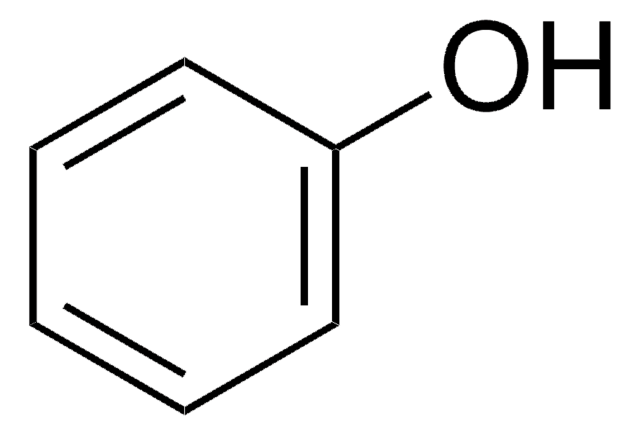33517
Phenol
puriss. p.a., ACS reagent, reag. Ph. Eur., 99.0-100.5%
Synonym(s):
Hydroxybenzene
About This Item
Recommended Products
grade
ACS reagent
puriss. p.a.
Quality Level
agency
reag. Ph. Eur.
vapor density
3.24 (vs air)
vapor pressure
0.09 psi ( 55 °C)
0.36 mmHg ( 20 °C)
assay
99.0-100.5%
99.5-100.5% (GC)
form
solid
autoignition temp.
1319 °F
expl. lim.
8.6 %
impurities
≤0.001% heavy metals (as Pb)
≤0.01% non-volatile matter
≤0.05% m-cresol (GC)
≤0.05% o-cresol (GC)
≤0.05% p-cresol (GC)
≤0.2% water (Karl Fischer)
bp
180-181 °C
182 °C (lit.)
mp
40-42 °C (lit.)
transition temp
solidification point ≥40.5 °C
density
1.071 g/mL at 25 °C (lit.)
anion traces
chloride (Cl-): ≤5 mg/kg
cation traces
Fe: ≤1 mg/kg
SMILES string
Oc1ccccc1
InChI
1S/C6H6O/c7-6-4-2-1-3-5-6/h1-5,7H
InChI key
ISWSIDIOOBJBQZ-UHFFFAOYSA-N
Gene Information
human ... GABRA1(2554)
Looking for similar products? Visit Product Comparison Guide
Related Categories
General description
Application
related product
signalword
Danger
Hazard Classifications
Acute Tox. 3 Dermal - Acute Tox. 3 Inhalation - Acute Tox. 3 Oral - Aquatic Chronic 2 - Eye Dam. 1 - Muta. 2 - Skin Corr. 1B - STOT RE 2
Storage Class
6.1A - Combustible, acute toxic Cat. 1 and 2 / very toxic hazardous materials
wgk_germany
WGK 2
flash_point_f
177.8 °F - closed cup
flash_point_c
81 °C - closed cup
ppe
Eyeshields, Faceshields, Gloves, type P2 (EN 143) respirator cartridges, type P3 (EN 143) respirator cartridges
Choose from one of the most recent versions:
Already Own This Product?
Find documentation for the products that you have recently purchased in the Document Library.
Customers Also Viewed
Our team of scientists has experience in all areas of research including Life Science, Material Science, Chemical Synthesis, Chromatography, Analytical and many others.
Contact Technical Service




